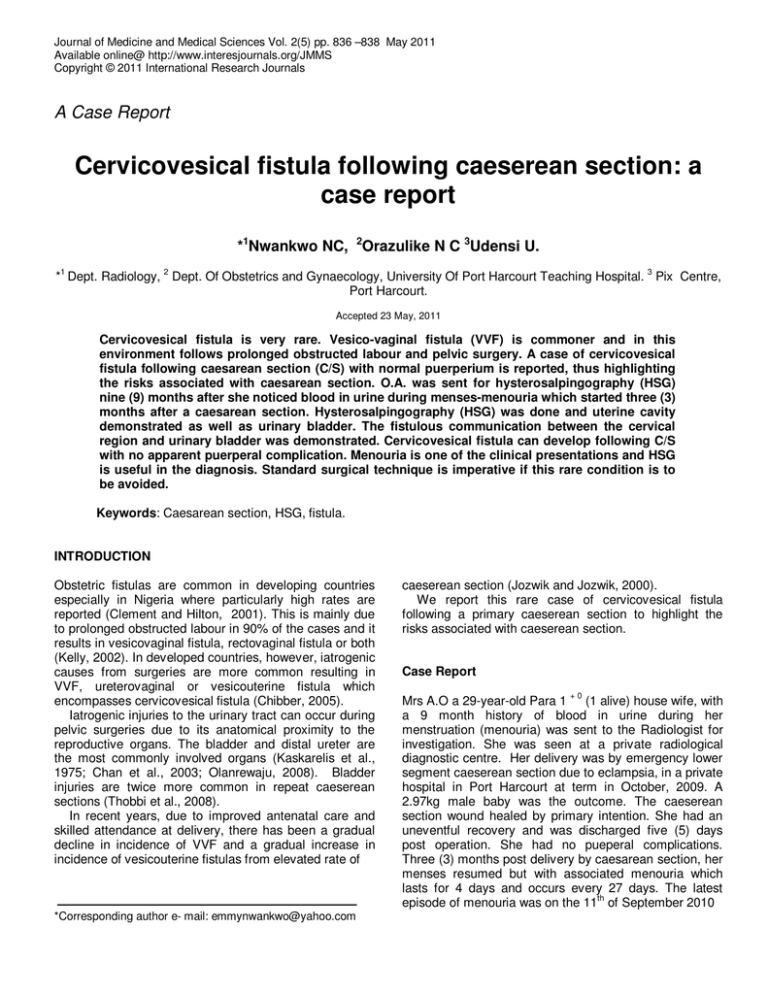Document 14233710
advertisement

Journal of Medicine and Medical Sciences Vol. 2(5) pp. 836 –838 May 2011 Available online@ http://www.interesjournals.org/JMMS Copyright © 2011 International Research Journals A Case Report Cervicovesical fistula following caeserean section: a case report *1Nwankwo NC, 2Orazulike N C 3Udensi U. 1 2 3 * Dept. Radiology, Dept. Of Obstetrics and Gynaecology, University Of Port Harcourt Teaching Hospital. Pix Centre, Port Harcourt. Accepted 23 May, 2011 Cervicovesical fistula is very rare. Vesico-vaginal fistula (VVF) is commoner and in this environment follows prolonged obstructed labour and pelvic surgery. A case of cervicovesical fistula following caesarean section (C/S) with normal puerperium is reported, thus highlighting the risks associated with caesarean section. O.A. was sent for hysterosalpingography (HSG) nine (9) months after she noticed blood in urine during menses-menouria which started three (3) months after a caesarean section. Hysterosalpingography (HSG) was done and uterine cavity demonstrated as well as urinary bladder. The fistulous communication between the cervical region and urinary bladder was demonstrated. Cervicovesical fistula can develop following C/S with no apparent puerperal complication. Menouria is one of the clinical presentations and HSG is useful in the diagnosis. Standard surgical technique is imperative if this rare condition is to be avoided. Keywords: Caesarean section, HSG, fistula. INTRODUCTION Obstetric fistulas are common in developing countries especially in Nigeria where particularly high rates are reported (Clement and Hilton, 2001). This is mainly due to prolonged obstructed labour in 90% of the cases and it results in vesicovaginal fistula, rectovaginal fistula or both (Kelly, 2002). In developed countries, however, iatrogenic causes from surgeries are more common resulting in VVF, ureterovaginal or vesicouterine fistula which encompasses cervicovesical fistula (Chibber, 2005). Iatrogenic injuries to the urinary tract can occur during pelvic surgeries due to its anatomical proximity to the reproductive organs. The bladder and distal ureter are the most commonly involved organs (Kaskarelis et al., 1975; Chan et al., 2003; Olanrewaju, 2008). Bladder injuries are twice more common in repeat caeserean sections (Thobbi et al., 2008). In recent years, due to improved antenatal care and skilled attendance at delivery, there has been a gradual decline in incidence of VVF and a gradual increase in incidence of vesicouterine fistulas from elevated rate of *Corresponding author e- mail: emmynwankwo@yahoo.com caeserean section (Jozwik and Jozwik, 2000). We report this rare case of cervicovesical fistula following a primary caeserean section to highlight the risks associated with caeserean section. Case Report +0 Mrs A.O a 29-year-old Para 1 (1 alive) house wife, with a 9 month history of blood in urine during her menstruation (menouria) was sent to the Radiologist for investigation. She was seen at a private radiological diagnostic centre. Her delivery was by emergency lower segment caeserean section due to eclampsia, in a private hospital in Port Harcourt at term in October, 2009. A 2.97kg male baby was the outcome. The caeserean section wound healed by primary intention. She had an uneventful recovery and was discharged five (5) days post operation. She had no pueperal complications. Three (3) months post delivery by caesarean section, her menses resumed but with associated menouria which lasts for 4 days and occurs every 27 days. The latest episode of menouria was on the 11th of September 2010 Nwankwo et al. 837 Uterine cavity with filling defect due to synechiae. Cervical canal Contrast in the urinary bladder Figure 1 showing contrast medium in urinary bladder through fistula in cervical canal as well as uterine cavity. and it was the cycle she had the HSG done. She neither had amenorrhoea nor urinary incontinence. Physical examination revealed a healthy looking young lady who was not pale, anicteric and afebrile. Her respiratory and cardiovascular systems were normal. There was a transverse suprapubic caeserean section scar. Other abdominal findings were normal. During the HSG procedure, vaginal examination revealed a normal vulva. The vulva was cleansed and a lubricated Cusco’s bivalve speculum gently inserted into the vagina. The cervix looked healthy, was located posteriorly with a closed external cervical os. Fifteen milliliters (15mls) of non ionic contrast medium scan lux was injected into the cervical canal using Everald Williams uterine canular. The cervical canal, uterine cavity and urinary bladder were demonstrated (Figure 1). The uterine cavity also showed a filling defect which was due to uterine synechia. Fallopian tubes were not demonstrated due to under filling as much of the contrast went into the urinary bladder through the fistula in the cervical canal. She was counselled on the findings at HSG, the need for possible surgical treatment and referred to the urologists. DISCUSSION Cervicovesical fistula, a communication between the cervix and bladder is a very rare complication compared to vesico vaginal fistula in developing countries. It is usually included as part of vesico uterine fistula which strictly is a fistulous communication between the posterior supratrigonal part of the bladder and the anterior lower segment of the uterus. Together, they both form the least common of genitourinary fistula constituting about 5% (Dare et al., 1997). Indeed, this is the first case seen in this facility out of over a thousand HSGs done between October 1995 till date. The emergence of ceaserean section as a safe obstetric surgery has revolutionised obstetric practice hence repeat ceaserean section has been a major contributor to the increased incidence of iatrogenic urological injuries. The reported incidence of bladder injury at time of C/S ranges from 0.14% - 0.5% (Dare, 1997; Phipps et al., 1981). Risk factors that are implicated include obstetric factors such as C/S following prolonged obstructed labour or failed instrumental vaginal delivery, uterine rupture and ceaserean hysterectomy. Others include surgical factors such as, dense adhesions from repeat C/S, attempts to control bleeding during C/S complicated by intra operative haemorrhage, fast C/S, surgical skill and experience of the operator. Since Mrs O.A’s surgery was done in a private hospital and due to an obstetric emergency – eclampsia, the last two factors may be indeed the cause of her fistula. Bladder injuries may occur due to inadequate mobilisation of bladder laterally and inferiorly, iatrogenic cystostomy during uterine incision, inclusion of bladder wall accidentally in sutures used to close uterine incision. When the sutures get resorped, a fistula forms and menouria occurs (Youssef, 1957). Cervicovesical fistula may develop immediately after C/S, late in the puerperium or occur after repeated procedures. Delayed fistula formation may be due to 838 J. Med. Med. Sci. haematoma formation, infection or devascularization of the bladder. Clinical presentations include menouria, urinary incontinence from fistulous communication, amenorrhoea from uterine synechiae and endometrial damage from metabolites in the urine. (Dare, 1997). They could also present with infertility from peritubal adhesions due to infection and endometriosis (Krajnovic et al., 1979). Since the fistula usually occurs at a higher level in the bladder, few patients develop urinary incontinence rather there is misdirection of menstrual flow through the fistula (Dare, 1997). The diagnosis of cervicovesical fistula is from history, clinical examination, demonstration of fistulous communication between the bladder and cervix by HSG and/or Intra venous urography (IVU). HSG clearly demonstrated this in Mrs OA. Cystoscopy, cystogram and hysteroscopy are also useful. When the only indication of a possible cervicovesical fistula is menouria rather than incontinence, retrograde hysterography may fill the bladder in like manner. Imaging has an important role in evaluation but is of limited role in initial diagnosis. A positive diagnosis is visualisation of a leak of contrast from a viscus but a negative can never exclude its occurrence (Howkins et al., 2001). Although small fistula may close spontaneously, most often surgery is required hence her referral. Route of repair may be transvaginal, transabdominal or transvesical. Occasionally, repair may not be possible without hysterectomy (Thobbi et al., 2008). This is the first reported case of cervicovesical fistula following primary C/S in Port Harcourt and probably in the whole of South South zone, hence the report. Surgeons should be aware of the risk factors highlighted, which increases the likelihood of bladder injury. They should also recognize the limits of their surgical skills especially in our environment where there are no regulatory bodies monitoring surgical practices so that serious morbid, social consequences and medicolegal problems can be prevented. REFERENCES Chan JK, Morrow J, Manetta A( 2003). Prevention of ureteral injuries in gynaecological surgery. Am J Obstet Gynaecol. 188(5): 1273 1277. Chibber PJ (2005). Laparoscopic O’ Connor’srepair for vesicovaginal and vesicocervical fistula. Int BJU. 96: 183 – 186 Kaskarelis D, Sakkas K, Aravantinos D, Machalas S, Zolotas J (1975). Urinary tract injuries in gynaecological and obstetrical procedures. Int Surg. 60(1): 40 - 43. Clement KM, Hilton P (2001). Diagnosis and management of vesicovaginal fistula. The Obstetrician & Gynaecologist. 3(4): 173 178. Dare FO (1997). Vesicouterine fistula. A report of four cases. Trop J Obstet Gynaecol. 14(1): 53 – 55. Howkins J, Setchell ME, Hudson CN (Eds). (2001). Genital Fistula th Shaw’s textbook of operative gynaecology, 6 edition. New Delhi: Churchill Livingstone. 238 - 272. Jozwik M, Jozwik (2000). Clinical classification of vesicouterine fistula. Int J Obstet Gynaecol. 70: 353 – 357. Kelly J (2002). Repair of Obstetric fistula. The Obstetrician & Gynaecologist. 4: 205 – 211. Krajnovic P, Smiljanic N, Gasparac B (1979). Asymptomatic post operative cervicovesical fistula as possible sterility cause. Arch Gynaecol. 228: 548 - 549. Olanrewaju S, Studd J, Tan SL, Chervenak FA (2008). . Urinary tract injuries at Caeserean section. In: (Eds), Progress in Obstetrics and th Gynaecology, 18 edition. Edinburgh: Elsevier. 237 - 247. Phipps MG, Watabe B, Clemens JL, Weitzen S, Myers DL (1981). Risk factors for bladder injury during Caeserean section. J Urol. 120: 372 Thobbi VA, Suguna V, Kamdod S, Patil SB (2008). Post repeat lower segment caeserean section cervicovesical fistula. Al Ameen J Med Sci. 1(2): 133 - 135. Youssef AF (1957). Menouria following lower segment caeserean section: a syndrome. Am J Obstet Gynaecol. 73: 759 - 767.





